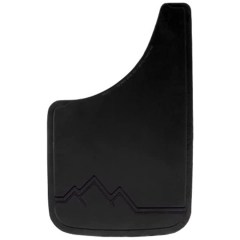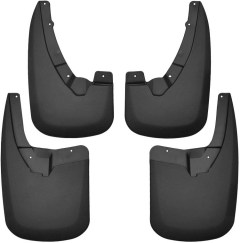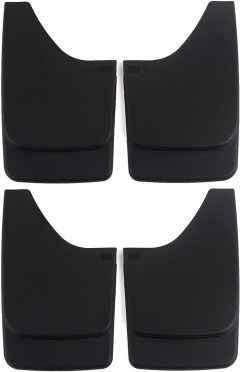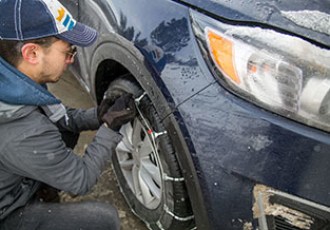BestReviews is reader-supported and may earn an affiliate commission. Details

Quality-built to maintain longevity in the harshest conditions.
Quality-built to maintain longevity in the harshest conditions.
Fiberglass backed to ensure durability year round. Holds shape in hot and cold climates. PVC material stops scratches and tears from the road.
The fit may not work for smaller trucks.

Built to fit most cars and trucks with easy installation.
Built to fit most cars and trucks with easy installation.
No drilling into the car required to install. Material is scratch-resistant. Multiple different choices of color.
Only comes with 2 instead of 4.

One of the best complete sets for truck owners wanting a custom, perfect fit.
One of the best complete sets for truck owners wanting a custom, perfect fit.
Heavy-duty product is designed to cover the exact width of the factory tires that come with most modern trucks. Thermoplastic resists deformation in bad weather.
Limited amount of compatible vehicles and model years. Requires exact mounting hardware.

A great option for people looking for a complete front-and-rear set.
A great option for people looking for a complete front-and-rear set.
The smaller pieces fit into most normal car and sedan wheel wells. Heavy-duty rubber resists flexing and breaking in bad weather with cold, subzero temperatures.
Poor fit and coverage with larger vehicles, such as trucks and full-size SUVs.

A basic set that is built to last.
A basic set that is built to last.
Product material is stiff enough to stay in place. Is big enough to cover wider sets of tires. Metal bottom helps protect underside of vehicle.
Not ideal for cars.

We recommend these products based on an intensive research process that's designed to cut through the noise and find the top products in this space. Guided by experts, we spend hours looking into the factors that matter, to bring you these selections.

Most people think mud flaps are designed to protect the vehicles behind you from water, mud, or gravel sprayed up from your tires. While that’s true, there are also selfish reasons for fitting them.
Mud flaps do a very effective job of protecting the lower edges and underside of your vehicle — and the paintwork — from all that muck and accumulated damage. As a result, your car or truck retains more worth when it comes time to sell it.
It’s important to get the right size mud flaps for your vehicle, but there are also different materials and fitting options to consider.

Mud flaps, mud guards, splash guards, they’re all basically the same thing. It should go without saying that the right size is important, but it’s an area where some people don’t pay as much attention as they should. Getting the wrong model is frustrating, so it’s always worth double-checking. You have two basic choices: drill or no-drill. A quick look under the wheel arch will tell you which type you’ve got.
Drill: These mud flaps are for vehicles without predrilled holes in the wheel wells. With these, you have to drill your own holes. “Universal” is a popular description for mud flaps, almost invariably the kind that requires drilling. However, there’s a limit to just how universal this fit is. There’s no such thing as a mud guard that fits every vehicle, so you still need to check the general specifications.
No-drill: These mud flaps fit vehicles that have predrilled holes in the wheel wells. No-drill mud flaps fit a specific position and spacing, so it’s even more important to check the year, make, and model of your vehicle. Small differences could mean the hole alignment will be an issue. It’s also common for front and rear mud flaps to be different sizes. Model differences will also cover things like dual rear wheel vehicles in which you don’t want the same mud flaps as you would if the rear axle had single wheels.
Fitting hardware is usually provided with mud flaps, often in the form of self-tapping screws (particularly on cheaper models). A popular alternative is to use nuts and bolts with a washer. While it may not be practical on all vehicles (you need to be able to reach inside the wheel arch to tighten the nut) the washer will help stop the fastener from wearing into and eventually pulling through the mud flap.
You’ll generally find mud flaps made of either thermoplastic (often just called plastic or PVC), rubber, or aluminum.
Plastic is usually used for mud flaps for cars. It’s easy to mold into more aerodynamic and visually pleasing shapes that follow the vehicle’s contours. It’s also light and relatively easy to color. Fiberglass is sometimes used for reinforcement.
The disadvantage with plastic is that it’s quite rigid, so in very muddy conditions or with melting snow, debris can build up between the wheel arch and the mud flap. You ought to clear it before continuing, but it usually occurs in the worst weather!
Rubber is a heavy-duty material frequently used for mud flaps designed for trucks, 4x4s, and big rigs where a large, durable flap is the priority. Unlike a plastic model, a rubber flap will flex out of the way, so debris doesn’t build up. Rubber is also popular with off-roaders and drivers who frequently drive in harsh conditions because they can cut down oversize versions to create their own custom mud flaps. It’s not something you can do with plastic mud flaps.
Aluminum mud flaps, usually polished to a bright finish, look great on trucks and semis. These are tough, but they don’t have any flexibility, so the impact of a stone at high speed might dent or deform them. They can also be reinforced with rubber in heavy-wear areas. Steel and stainless-steel sections may also be used for this purpose.
Under normal circumstances, weather has little effect on the structure of mud flaps, but if you regularly drive in extreme conditions, it’s worth checking their resilience. Some models are made for use in subzero temperatures or extreme heat, but you’ll rarely find precise figures. If that’s important to you, you’ll need to contact the manufacturer.
Custom flaps: If you’re particularly proud of your Dodge Ram, Ford 150, or another vehicle, you can find custom-branded mud flaps, though you will often pay a premium for them. What’s more, the cheaper, non-branded product often comes from the same manufacturer!
Patterns: You’ll sometimes see ribbing molded onto the rear side of mud flaps near the bottom, or an industrial-style diamond plate pattern. You might wonder what purpose these could serve because they’re not on the part that gets hit by water or stones. The answer (and even the manufacturers admit this) is that they’re purely decorative.

Q. Are mud flaps required by law?
A. It depends on where you live. There are no federal laws, but in Alaska, California, Nebraska, and Louisiana, some form of “spray suppression device” is required. Several other states require them if no rear fender is fitted. On semis, it’s usually necessary to fit mud flaps to the rear wheels of the tractor unit and the trailer. Each state has its own rules, and these may have changed since the last time you checked, so it’s a good idea to stay current.
Q. How big do mud flaps need to be?
A. Again, it’s important to check state laws (and it’s especially important for commercial truckers and semi drivers traveling across state boundaries). Most demand that the mud flap is at least the full width of the tire tread and reaches 6 inches or less above the road surface.
Q. Are mud flaps difficult to fit?
A. They aren’t technically challenging, but the job can be time-consuming. The no-drill types are very straightforward. Just check for “LH” and “RH” markings so you know which side of the vehicle to fit them. A few are just push fit, though most need a fastener. You need to be careful if it’s necessary to drill into your wheel well. Manufacturers provide instructions, and you can find videos online. On some vehicles, the clearance for the drill can be tight with the wheels in place, so you might need to remove them. As with any job on your vehicle, if you’re not confident, it’s best to take it to a professional.
Get emails you’ll love.
Learn about the products you’re wondering if you should buy and get advice on using your latest purchases.
